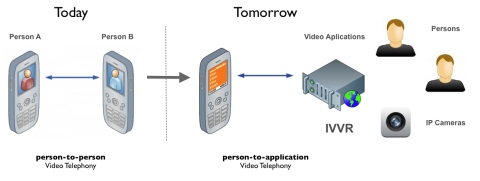
Thanks to Christoph Köpernick’s from www.ivvr.de blog, we are very please to reference his point of view about the video IVR / IVVR challenge today for telecom’s services evolution: from person-to-person to person-to-application 3G video telephony.
Interactive voice and video response (IVVR) is a mobile technology that enables interactive services based on a 3G video call. IVVR is using the 3G video call technology to deliver applications and services to 3G users. In contrast to person-to-person video telephony, an application server answers when a 3G user places a video call. The application server generates and transmits an audio and video stream that is shown on the handset of the caller.
Instead of a real person or scene, the application server can transmit any kind of audio and video—whether a pre-recorded “talking head”, movie trailer, a live feed from TV, or a video showing traffic information—or even the order process for electronic shopping. As 3G video calls are generally bidirectional, the user is automatically sending the handset’s build-in camera and microphone signals to the other party. This paves the ground for interactive applications based on gesture and speech recognition. Another, simpler way to realise interaction is by processing DTMF (Dual-Tone Multi-Frequency) signals sent with the 3G-324M session when the caller uses the handset’s numpad to type.
The term IVVR is derived from interactive voice response (IVR (Interactive Voice Response)). IVR is an interactive content-to-person service and a prevalent technology to IVVR. IVR allows callers to retrieve information, make bookings, and get connected with a contact based on the caller’s selection. IVR applications are written mostly in VoiceXML to describe a simple series of voice menus where the caller chooses from a given selection of options or makes spoken requests when the IVR system supports natural language speech recognition. Based on the caller’s selection and purpose of the IVR application, the system plays pre-recorded audio clips, dynamically generates speech, or connects the caller with a person of charge. Although IVR systems are flexible, used extensively, and accessible through most mobile and landline phones, they show some limitations. The IVR system can respond only in the auditive dimension; complex menus need to be broken down to limited choices. When these choices are nested, it can be tedious for callers to dig through a complex voice menu or remember the series of choices. Voice-only communication also excludes the dumb from using IVR.
Simply said, IVVR is based on video telephony and adds a visual dimension to IVR, enabling service providers to create new services that take advantage of media streaming capabilities.
Complete article at www.ivvr.de here.